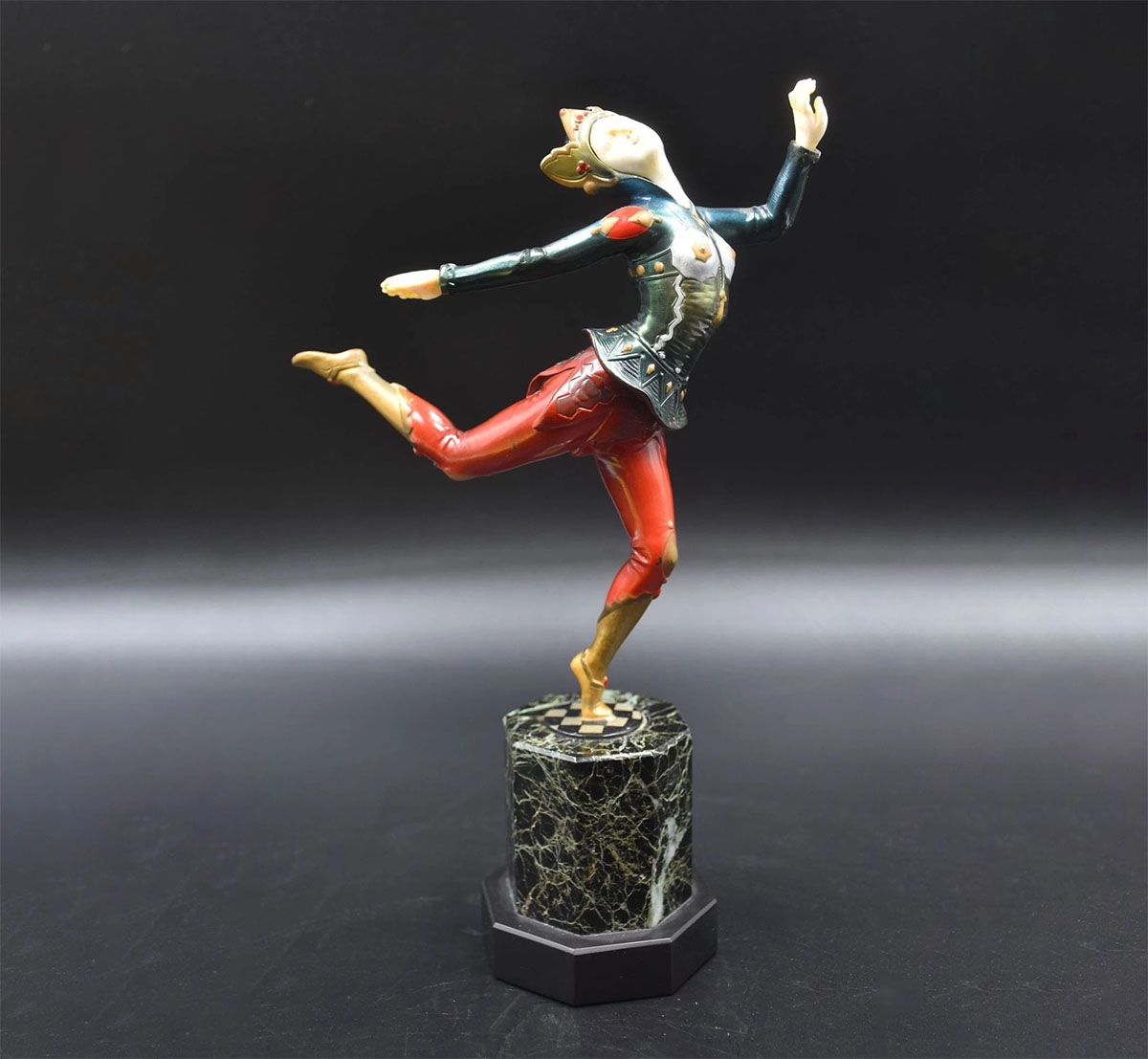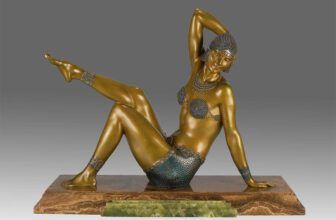
Gustav Schmidt Cassel Art Deco Sculpture
Born in Kassel in 1867, Gustav Schmidt Cassel studied sculpture in Berlin under Ernst Herter, eventually taking over his teacher’s studio and becoming a prominent figure in German sculpture. Early commissions included public monuments, such as a monumental equestrian statue of Peter the Great in Riga and a memorial to Emperor Frederick III in what is now Poland . However, the roaring energy of the 1920s would redefine his legacy.
Schmidt‑Cassel and Art Deco: Exotic Movements in Bronze
By the 1920s, Schmidt‑Cassel turned to small‑scale figural bronzes in the Art Deco style. He became known for statues of exotic dancers and performers, models often later realized by Rosenthal & Maeder or Preiss & Kassler workshops in Berlin . His figures embodied elongated elegance, intricate costumes, and dynamic motion.
Eastern Dancer and Coy Dancer
His ornate cold‑painted bronze with ivory details, often depicting “Eastern Dancers”, are considered his most famous works. At a rare selling at Sotheby’s London in 2010, one such piece titled Eastern Dancer sold for £10,000–15,000, realizing a record £11,000+ (~$26,000) . Another piece known as Coy Dancer, circa 1925, achieved £8,000–12,000 at Christie’s .
How Schmidt‑Cassel Created His Sculptures
Training & Travels
After academic training, he traveled through Italy, Paris, and Russia, absorbing influences that shaped his exotic visual vocabulary .
Models & Production
Schmidt‑Cassel often sculpted gypsum or wax prototypes which were broadcast into small statuette series. Factories in Berlin then produced them in cold‑painted and gilt bronze, often combined with ivory and marble bases. Many models were made for firm editions by Rosenthal & Maeder or Preiss & Kassler.
Materials & Technique
His bronzes reveal refined surfaces and crisp detailing, costumes richly painted, with flashes of gilt or ivory inlays. Marble or onyx plinths provided luxurious contrast. He often used the traditional lost‑wax casting method to capture subtle textures. Cold-painting enhanced realism and expressiveness, especially in the face and costume decorations .
Signature Works & Themes
“Snake Charmer” / Eastern Dancer
A recurring theme in Schmidt‑Cassel’s deco bronzes is the exotic dancer hypnotizing a snake. Variations include gilt bronze, cold‑painted surfaces, ivory headpieces, and marble bases. One notable example is estimated at €8,000–12,000 at Burchard Galleries .
“Coy Dancer” & Other Performers
Another popular type is the coy, demure dancer, expect stylized pose, extended arms, and decorative headdresses. One Coy Dancer sold for £8,000–12,000 at Christie’s, circa 13½ inches high.
Other Motifs
Less often, Schmidt‑Cassel sculpted mother‑and‑child pairs, allegorical figures (e.g. Mädchen mit Schmetterling – Girl with Butterfly), and figures like warriors or symbolic bronze studies. Those pieces typically fetched more modest sums, several hundred to a few thousand euros.
How Much Are Gustav Schmidt Sculpture Worth?
Prices vary widely: here’s a breakdown of typical realized auction prices (in USD/EUR):
| Sculpture Type | Estimated Price |
|---|---|
| Eastern Dancer (gilt/cold) | £10k–15k (~$13k–20k; €11k–17k) |
| Coy Dancer (polychrome) | £8k–12k (~$10k–14.5k) |
| Dancer bronze small | |
| Maiden with Butterfly | €600‑1,200 (~$650–1,300) at modest auctions |
| Minor figures or copies | Often €200–600 (~$240–700) |
His top-tier signed chryselephantine or gilt figures often break the $15,000–26,000 barrier. Lesser bronze versions or unsigned copies trade in the €200–1,500 range.
Where to Find Schmidt‑Cassel’s Sculptures
Auctions worldwide: Sotheby’s, Christie’s, Bonhams, Abell, Skinner, and numerous European auction houses like Bukowskis and Mehlis have sold his works.
Museum exhibitions: His work appeared in Art Deco exhibitions such as those at the State Hermitage Museum in St. Petersburg, highlighting his role in 1920s sculpture.
Private collections & galleries especially in Germany, Western Europe, and the U.S.: collectors and galleries specializing in vintage Art Deco décor and Bronze statuettes.
Specialist antique dealers: examples listed on sites like art‑bronze‑sculptures.com or Invaluable show available pieces spanning his career .
Picture a glamorous salon in pre‑war Berlin: soft light filters through tall windows, bouncing off glossy parquet floors. A golden‑brown bronze Snake Charmer commands attention on a pedestal – her sinuous pose lithe, costume gleaming. A hush settles over guests as the serpent appears to coil mid‑air.
This is Schmidt‑Cassel’s world: a fusion of exotic performance and refined modern elegance. Trained by Herter, he absorbed classical technique, yet transformed it with 1920s flair. His dancers, caught in mid‑motion, capture the cultural longing for escapism and glamour after World War I. Each fold of costume, each polished gesture, reflects meticulous bronze mastery and pop-of-colour cold paint.
A young collector examines a smaller Coy Dancer onyx‑based piece in his hands. Light picks out the polychrome details on her headdress; the finish still vivid. He imagines the original edition executed in a Berlin workshop, perhaps sold through Rosenthal & Maeder. He knows this is one of the rarer signed editions, worth €8k‑12k.
Elsewhere, modest figures like Maiden with Butterfly embody quieter charm: a girl with a delicate butterfly perched on her palm. Though smaller in scale and price, these works show Schmidt‑Cassel’s tenderness and his roots in Jugendstil before pivoting to dramatic Art Deco.
Gustav Schmidt‑Cassel Legacy & Why It Matters
Gustav Schmidt‑Cassel is known for bridging classic training and Art Deco sensibility, creating dynamic dancer figures rich with exoticism that resonated across Europe and America. His sculptures remain collectible today for:
Exceptional craftsmanship, especially in gilt and cold‑painted bronze combined with ivory and marble.
Iconic Art Deco choreography and aesthetic aligned with the era’s taste for movement, luxury, and elegance.
Historical relevance: his models reflect post‑WWI cultural cosmopolitanism, Berlin’s artistic vibrancy, and industrial sculpture production.
Whether in major museum shows or private collections, his sculptures continue to fascinate connoisseurs of the period.
Gustav Schmidt‑Cassel’s most famous works, Eastern Dancer, Coy Dancer, and other stylized performer statuettes, epitomize exotic elegance in bronze. Crafted through academic mastery and industrial production, often finely detailed and accented with cold‑paint and ivory, they command anywhere from hundreds to tens of thousands of euros at auction, depending on rarity and condition.
His legacy is preserved in major auction records, period catalogs, exhibitions like those at the Hermitage, and in the lasting allure of vintage Art Deco sculpture. Each dancer staging a performance in metal carries forward the glamour and cosmopolitan spirit of the 1920s, making Schmidt‑Cassel a name worth remembering. image /mutualart




